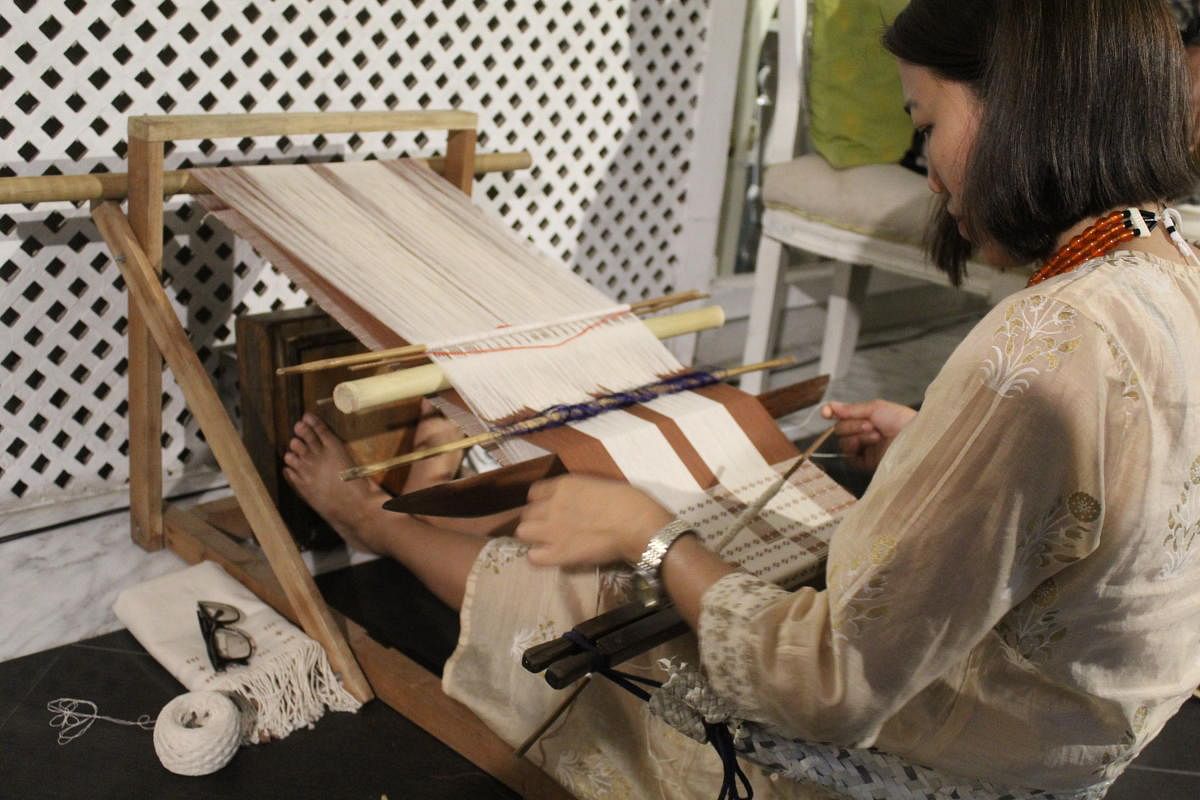

Contrary to popular belief, weaving is actually India’s second-largest employing industry, right after agriculture. Plus, Indian weaves are renowned worldwide and fetch good prices abroad.
Their appreciation within India may be limited but the scene is changing for good.
Textiles by Nagaland’s Lovitoli are now sold all over India and even outside. Jyotshna Kalita’s regional textiles from Nahira village in Assam, now have a bigger market than they used to. She saw an increased demand during the pandemic. The same is the case for Rajesh Guin, a weaver from Gopalpur town in Odisha, whose sales rose dramatically during the last two years. The story is similar for many other weavers from small towns in India.
In order to learn about the art, design inspirations and the labour that goes behind handwoven clothing, DH on Saturday spoke to a few weavers who had come from four states at an exhibition held recently at Taj West End Bengaluru. The weavers were brought together by an initiative of the Antaran-Tata Trusts.
Nagaland
Lovitoli learnt the technique of weaving at a young age and made it her livelihood. Her motivation to learn the loomwork was to preserve her cultural pride.
She works on a loin or backstrap loom, which is the most primitive style of weaving, where one end of the warp is tied to a bamboo and the other end is strapped to the body of the woman weaver.
Lovitoli says, “In this technique, each strand of yarn is handpicked to produce unique geometric patterns with designs rooted in tradition, culture, and mythology. For every loin loom, there is a cultural context that could be linked to the tribe’s identity or to the wearer’s rank or their accomplishments individually.” The textiles of Nagaland are a reflection of culture for both the weaver and the wearer, she adds.
Sejal Agarwal, a craft textile designer who works with Lovitoli, says, “Traditional Naga clothing includes feathers, cowries and other shells, bamboo, bones, beads, fur, ivory, red-dyed goat hair, and various native textiles.” Every Naga tribe has a specific shawl that denotes rank and prestige. “Unique motifs were exclusively used in these high-status shawls, such as the elephant — a symbol of power, richness, and success,” she adds.
Assam
Jyotshna Kalita is an artisan-entrepreneur from Nahira village in south Kamrup, Assam. Having an eye for detail, she draws inspiration from nature.
“Assam comprises both tribal and non-tribal population and I weave designs inspired by both communities,” she says.
She talked about some tribal designs that are common there. “‘Rajampai aareu’ is a tribal fabric from Assam on which tribal designs are done. Weaves work on a graph of small designs and the patterns are predominantly squares, with floral tracery inserted between the colour strips,” she tells.
Jyotshna also weaves the traditional ‘gamosa’ and ‘mekhla’. Gamosa is a piece of white cloth, featuring patterns of stylised birds, animals, flowers, foliage, and geometric motifs on both ends. Some of her mekhla designs are also inspired by Tibetan and Burmese styles.
She works on Eri silk, also known as Ahimsa silk, which has a coarse and dense texture, unlike other silks. The fibre is extracted from the cocoons of Eri silkworm without killing the larvae inside. She says this fabric is symbolic of peace, grace, and longevity.
Odisha
Rajesh Guin picked up the loom only three years ago. He is now a master of both traditional and cutting-edge designs alike. Rajesh comes from a family of weavers who were struggling. Since the government only provides a small subsidy, he says, having an entrepreneurial mindset is a must in this industry.
Rajesh mostly works on Tussar silk but is also exploring Eri or Ahimsa silk, and mulberry silk. His designs are inspired by Hindu mythology. Rajesh sees his loom as a canvas. He has worked on mythological sequences, including the Ramayana’s Shravan Kumar, depictions of love between Radha and Krishna, and also motifs inspired by the Jagannath Puri temple and the Taj Mahal.
Rajesh says, “One of the artisanal skills associated with Gopalpur is their use of handspun and hand-reeled yarns.” A catchy display at the exhibition was the ‘Gita Govinda Ikat Sambalpuri’ sari by tie-dye artist Bhikari Meher. He says, “The flute and the peacock feathers represent love, peace, and immortality. The dominant and yellow colours show the conjugality of the divine lovers — Radha and Krishna.”
Andhra Pradesh
Venkatagiri sari is woven in the Nellore district of Andhra Pradesh. The Geographical Indications of Goods Act of 1999 designated it as a geographical indication (GI) from Andhra Pradesh. These saris are noted for their exquisite weaving and are often worn by celebrities and royals alike. The weaving style is called ‘counted thread weaving’.
“Counted thread weaving is seen as a tremendous development in textile with the inculcation of patterns that are generated utilising the unique technology of loom embroidery,” explains Patnamsubranyam, an expert in the form. As a result, the extra weft technique necessitates a more time-consuming process and a larger number of workers. Big Jamdani motifs of birds, swans, peacocks, and mango or leaf designs decorate the pallu of this weave.